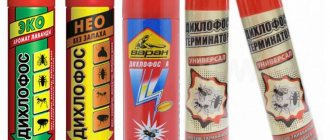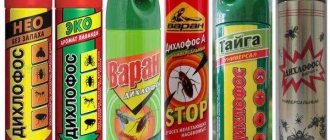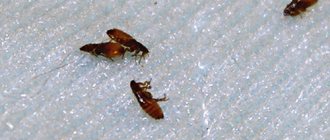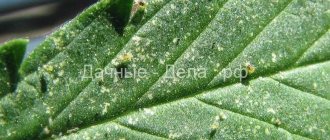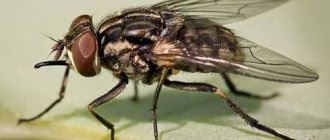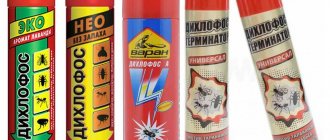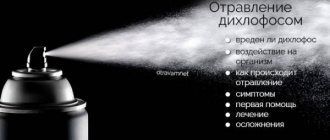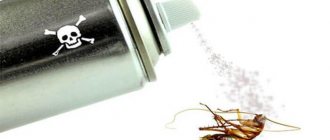Insect control has long become a daily occurrence in the modern world. There are many products that are used for different purposes: getting rid of parasites in the house or in nature (in vegetable gardens, garden plots). The most famous and widely used drug is dichlorvos.
This remedy has been so popularized since Soviet times that in our time it has already become a household name for many people. You should understand in detail what kind of remedy this is, whether it can harm people and what actions to take if the toxin enters the body.
What is it and what is it used for
Dichlorvos is a broad-spectrum insecticide against flying and crawling insects in industrial, commercial and residential premises.
The original composition of Dichlorvos was very dangerous, but now it is produced differently. The current formula uses pyrethroids instead of dangerous toxins, making the insecticide more gentle. The effectiveness was not affected by this, but for humans Dichlorvos is now not as dangerous as before.
In stores you can find its varieties with the same name, but with explanatory prefixes - Neo, Eco, Super, etc.
So is it possible to be poisoned by Dichlorvos if the pyrethroids that became the basis of its composition are low-toxic and not so dangerous for humans? Considering that the drug remains a chemical agent, under certain conditions it is possible to be poisoned by Dichlorvos.
Chemical composition
Soviet "dichlorvos" was produced on the basis of dimethyl-dichlorovinylphosphate (hence the name). This organophosphorus compound was extremely toxic and had a strong, unpleasant odor. The modern aerosol "Dichlorvos Neo" does not contain dichlorovinyl phosphate and, according to the packaging, has no odor (although in fact there is an unpleasant sweetish aroma).
The new product is produced based on substances of the pyrethroid group:
- piperonyl butoxide (0.50%);
- cypermethrin (0.20%);
- permethrin (0.16%);
- tetramethrin (0.16%).
Additional components (ethyl alcohol, fragrances, stabilizers and preservatives) help hide the unpleasant odor. In addition to “Neo”, products with the prefixes “Eco”, “Varan”, and “Triple Impact” have the same composition. There is not much difference between them.
Causes of poisoning
Dichlorvos can be poisoned in three ways: by ingestion, on the skin, or by inhalation of its vapors. This happens for a number of reasons:
- treatment of premises without special form and ventilation,
- intentional ingestion or subcutaneous injection for the purpose of committing suicide,
- the chemical accidentally ended up in the hands of children,
- children, pregnant women and animals were not evacuated from the premises at the time of treatment.
Dichlorvos is assigned hazard class 3, which indicates its low toxicity, so you can only become poisoned by it due to your own carelessness. An amount of insecticide equal to 0.5–2 g can be a lethal dose.
Symptoms
Signs of Dichlorvos poisoning depend on how the insecticide entered the body.
If the product gets on the skin, the victim may experience:
- burning,
- redness,
- tingling,
- signs of allergy (itching, swelling, etc.).
If Dichlorvos gets into the eyes due to careless spraying, the following will appear:
- redness of the membrane,
- itching and pain,
- increased lacrimation,
- conjunctival discharge.
Vapor poisoning will cause the following symptoms in a person:
- headache,
- dizziness,
- runny nose,
- cough,
- respiratory tract irritation,
- temperature 38–39 °C,
- loss of coordination
- nausea with uncontrollable vomiting.
Read also: Headache during poisoning
Symptoms of Dichlorvos poisoning when ingested are the most severe compared to the previous ones:
- painful vomiting,
- diarrhea,
- increased sweating,
- blurred vision,
- difficulty breathing,
- convulsions.
In addition to the general symptoms described above, there are stages of Dichlorvos poisoning. They can be used to judge the severity of the victim’s condition.
Can dichlorvos harm humans?
If we look at aerosol cans called dichlorvos, we can notice the presence of pyrethroids in the composition. Auxiliary components include preservatives, alcohol and hydrocarbons.
For insects, pyrethroids pose a great danger, as they can cause paralysis and death in just a few hours. They can cause minor harm to humans. While in the human body, under the influence of the liver, permethrins break down into metabolites that are safe for humans. As a result, dichlorvos poisoning is possible, although the probability is low.
Read also: Edible and inedible mushrooms: how to determine toxicity
Stages of poisoning
There are only 3 stages of Dichlorvos poisoning, and each of them is characterized by its own symptoms:
- Stage of increased arousal. It appears after a few minutes, begins with an inexplicable surge of strength (the person literally rushes from side to side), but this is accompanied by an inability to control movements. Blood pressure rises, pupils constrict, and tachycardia develops. The victim becomes dizzy and has a migraine. The salivary glands work in an enhanced mode (saliva drips from the mouth).
- Stage of coordination disorders. Appears after a few hours. The patient's condition as a whole worsens. The urge to go to the toilet becomes more frequent, while urination and defecation are accompanied by pain. It is difficult for a person to breathe, vision becomes blurry, tremors of the limbs and body convulsions appear, saliva is already flowing in a continuous stream. Gradually the poisoned person falls into a stupor. In the absence of help, pulmonary edema develops and death occurs.
- Paralytic stage. A person loses consciousness, all reflexes are lost, paralysis of muscles and breathing occurs. Blood pressure drops and bradycardia develops. If you do not help in time, the victim will die within a day or earlier.
In children, due to their still fragile immunity, all signs of poisoning develop much faster, so you need to call a doctor at the first signs of intoxication.
First aid
To successfully resolve the problem, quick and competent actions of everyone who is close to the victim are important. In case of Dichlorvos poisoning, all symptoms will depend on the route through which the insecticide entered the body, and this must also be taken into account when providing assistance.
If Dichlorvos gets into your eyes, they should be thoroughly rinsed under running water or a 2% soda solution (1 teaspoon per 1 glass of water). Saline solution can be used for the same purpose. If the eyes are red, after rinsing, you need to instill anti-inflammatory drops, apply a bandage and consult an ophthalmologist.
If Dichlorvos gets on the skin, treat the affected area with a 2% soda solution or wash with soap and water. It is forbidden to rub the place where the poison has entered, since mechanical action on irritated skin allows toxins to penetrate even deeper.
Read also: Poisoning in humans with cottage cheese
A victim who has inhaled Dichlorvos vapor should be quickly evacuated to fresh air, rinse the nostrils and mouth with water. The patient must remove all clothing that has been in contact with the insecticide and may also have a poisonous effect. After this, put the person to bed and provide him with peace.
If some of the poison gets inside, first aid for Dichlorvos poisoning should be provided especially quickly and carefully:
- give the victim plenty to drink,
- make him vomit
- give any sorbents,
- an hour later - saline laxative medicine,
- do an enema (if you have the skill),
- ensure frequent and abundant drinking (teas, jelly, water are suitable),
- create conditions for bed rest and rest,
- further, monitor the patient’s compliance with a special diet, including light food (and be sure to give kefir, which perfectly restores intestinal flora).
Thus, all assistance measures should be aimed at removing toxins and further alleviating the patient’s condition.
If an allergic person suffers from Dichlorvos, you should urgently give him antihistamines (Suprastin, Tavegil, as well as ointments for skin lesions). If a child under 1 year of age has been poisoned, calling a doctor is necessary in any case.
Mild poisoning with Dichlorvos does not require medical intervention and usually goes away on its own in 2-3 days. But there are situations when the victim needs professional help, which can only be provided in a hospital department.
How to use the aerosol
It is believed that the treatment procedure with dichlorvos is not complicated, but it requires full compliance with the rules. If you deviate from them, the result is not guaranteed and there may be a threat to human health. Initially, according to the standard, one 190 ml can should be enough for 30 square meters, but it is best to purchase it with a reserve in order to separately walk through secluded corners where pests can hide.
According to the instructions for using dichlorvos neo, the procedure depends on the type of insect:
Flies and mosquitoes - it is necessary to spray the aerosol on glass, window frames, doors and cabinets, as this is where flying insects most often accumulate.- Moth - spray the product in cabinets at a ratio of 2 seconds per 1 cubic meter.
- Cockroaches and bedbugs are the most difficult to deal with. Possible habitats: cracks or wooden furniture parts; the reverse side of paintings, carpets, wall clocks, mirrors; under peeling wallpaper; behind skirting boards and radiators. To be effective, you need to spray directly on the pest itself, so you will need to move or disassemble furniture - a favorite place for bedbugs.
- Fleas - in this situation, walls up to a height of about a meter are treated. It is recommended to throw away the animal’s sleeping place or treat it, and then wash it thoroughly.
- Killing ants is the simplest thing - you don’t need to treat the entire room, just treating the ant paths is enough.
In any case, the can must be held at arm's length at a distance of 20-25 cm from the target. Spray for no more than five seconds.
After treatment, immediately leave the room to avoid inhaling the chemicals. Ventilation can begin within 30-40 minutes for a period of two hours. Afterwards, thoroughly wash all surfaces on which the product has come into contact.
Treatment
An ambulance team arriving on call will necessarily hospitalize a person if his condition, in the opinion of doctors, requires it. The doctor will determine what to do in case of poisoning in each specific case, but basically these will be the following measures:
- gastric lavage with a probe (if necessary - twice),
- elimination of seizures,
- Alox or atropine sulfate as an antidote,
- therapy to maintain cardiac function,
- antibacterial drugs to avoid the development of secondary infection,
- Ventilation for breathing problems.
Symptoms and treatment after Dichlorvos poisoning are closely interrelated, and all therapeutic actions will be carried out depending on the routes of penetration of the poison and the patient’s condition.
Consequences
Health problems as a result of exposure to Dichlorvos can appear both immediately after poisoning and after some time. In this regard, complications and long-term consequences are distinguished.
Complications develop within two weeks after intoxication and lead to the following diseases:
- dystrophy of the heart muscle,
- toxic hepatitis,
- nephropathy,
- pneumonia.
Read also: Carbon monoxide poisoning in humans
Long-term consequences develop within 3 years after Dichlorvos poisoning:
- damage to the peripheral nervous system (polyneuritis),
- disruption of the autonomic system, leading to dysfunction of internal organs (astheno-vegetative syndrome),
- combined inflammation of the spinal roots and spinal cord (myeloradiculitis).
The consequences of intoxication during pregnancy will be no less serious. If a woman in early pregnancy is poisoned, this can cause fetal death. It is not recommended to contact Dichlorvos in the later stages, as this can also be fatal for the unborn child.
Have you ever been poisoned with dichlorvos?
- Yes it was
- No, it was not
- Now there are symptoms of intoxication
ResultsPoll Options are limited because JavaScript is disabled in your browser.
- No, there was not 59%, 180 votes 180 votes 59% 180 votes - 59% of all votes
- Currently there are symptoms of intoxication 29%, 89 votes 89 votes 29% 89 votes - 29% of all votes
- Yes, there were 12%, 36 votes 36 votes 12% 36 votes - 12% of all votes
Total votes: 305 08/12/2017 You or from your IP have already voted. Vote
- Yes it was
- No, it was not
- Now there are symptoms of intoxication
You or from your IP have already voted. results
Links[edit]
- ^ a b "Dichlorvos". Haz-Map
. US National Library of Medicine. August 2015. Retrieved October 13, 2015. - Jump up
↑ Das S (2013).
"Review of dichlorvos toxicity to fish". Current World Environment Journal
.
8
(1). DOI: 10.12944/CWE.8.1.08. - “Which pesticides are banned in Europe?” (PDF). pan-europe.info
. April 2008 - ↑
Gillett JW, Harr JR, Lindstrom FT, Mount DA, St Clair AD, Weber LJ (1972).
"Evaluation of the human health hazards of dichlorvos (DDVP), especially in polymer strips." Remnant Reviews
.
44
: 115–59. DOI: 10.1007/978-1-4615-8491-9_6. ISBN 978-0-387-05863-4. PMID 4576326. - Pancetti F, Olmos C, Dagnino-Subiabre A, Rosas Morales C (December 2007). "Noncholinesterase effects induced by organophosphorus pesticides and their relationship with cognitive processes: implications for acylpeptide hydrolase action." Journal of Toxicology and Environmental Health, Part
B.
10
(8): 623–30. CiteSeerX 10.1.1.334.9406. DOI: 10.1080/10937400701436445. PMID 18049927. - Jump up
↑ Booth ED, Jones E, Elliott BM (December 2007).
"Review of the genotoxicity of dichlorvos in vitro and in vivo". Regulatory toxicology and pharmacology
.
49
(3): 316–26. DOI: 10.1016/j.yrtph.2007.08.011. PMID 17936460. - Espeland WE, Irestedt M, Johanson KA, Åkerlund M, Berg JE, Källersjö M (January 2010). "Exposure to dichlorvos interferes with the extraction and amplification of insect DNA in museum collections". Frontiers of Zoology
.
7
: 2. doi: 10.1186 / 1742-9994-7-2. PMC 2819063. PMID 20148102. - Mennear JH (June 1998). "Dichlorvos: a regulatory puzzle." Regulatory toxicology and pharmacology
.
27
(3): 265–72. DOI: 10.1006/rtph.1998.1217. PMID 9693077. - "Dichlorvos (DDVP): Removal of some uses and directions". US Environmental Protection Agency: Office of Pesticide Programs. April 19, 1995 pp. 19580–19581. Duty control number OPP-38511
- ↑
Wines M (September 11, 2014).
"Pesticide levels in waterways have fallen, reducing risks to people". New York Times
. - Jump up
↑ Brooks M (May 17, 2010).
"Organophosphate pesticides associated with ADHD". Medscape
. - Jump up
↑ Bouchard MF, Bellinger DC, Wright RO, Weisskopf MG (June 2010).
"Attention-Deficit/Hyperactivity Disorder and Urinary Organophosphate Pesticide Metabolites" (PDF). Pediatrics
.
125
(6):e1270-7. DOI: 10.1542/peds.2009-3058. PMC 3706632. PMID 20478945. - Raeburn P (14 August 2006). "Slow action". Scientific American
. Vol. 295 no. 2. paragraph 26. DOI: 10.1038/Scientificamerican0806-26. - ^ ab NIOSH Pocket Guide to Chemical Hazards. "#0202" . National Institute of Occupational Safety and Health (NIOSH).
- "Predominant effect of dichlorvos (vapon) on DNA polymerase-deficient bacteria" (PDF). Cancer Research
. - "Grand Court Victory for Public Health". NRDC
. - ^ a b "Dichlorvos". Immediately hazardous to life or health (IDLH) concentrations
. National Institute of Occupational Safety and Health (NIOSH). - Brunner, John (1972). Sheep look up
. New York: Ballantine Books. p. 220. ISBN 978-0-06-010558-7. LCCN 72-79705.
Prevention
All preventive measures come down to following simple rules:
- Treat premises with Dichlorvos only in a protective form (all parts of the body must be covered and a respirator must be worn).
- When spraying and after it, the room should be well ventilated.
- Do not use Dichlorvos if you are pregnant or prone to allergies.
- When spraying an insecticide at home and for another 4–6 hours after that, all people and animals should be removed from the room (especially children, pregnant women, allergy sufferers, and the elderly).
- After treatment, all work surfaces must be washed (tables, door handles, armrests, etc.).
- Buy Dichlorvos only in the store (not in dubious markets where a lot of clandestinely produced goods are sold).
- Keep dangerous substances away from children.
- If you have no experience in disinfestation, do not carry it out yourself (call SES employees).
Since the composition of modern Dichlorvos is relatively safe, poisoning with this chemical can only be done intentionally or in case of gross violations of the rules of use. With a responsible approach and understanding that the work is carried out with chemicals, cases of intoxication are excluded.
Flaws
Professional exterminators recommend using a toxic aerosol to combat pests and parasites when harmful insects are actively breeding. If the population has reached alarming proportions, weaker drugs do not help, you will have to buy Dichlorvos. If the number of parasites and pests is small, it is advisable to choose an insecticide from a different group.
Causes:
- organophosphorus compounds are toxic, negatively affecting not only ticks, cockroaches, flies, fleas, but also people and pets;
- Care is required when working with the drug: the lack of protective equipment quickly causes toxic damage to the body.
Warning! It is prohibited to spray a toxic product on bedding, pet hair, surfaces, containers and cabinets where food, medicines, and hygiene items are stored. Violation of the rule causes negative reactions in humans and pets.


